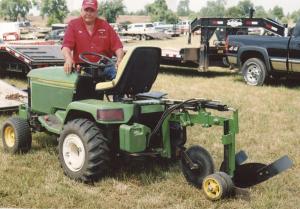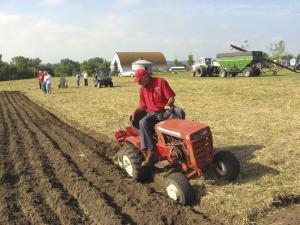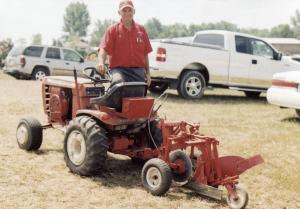2010 - Volume #34, Issue #5, Page #42
[ Sample Stories From This Issue | List of All Stories In This Issue | Print this story
| Read this issue]
Competition Plowing Comes To Garden Tractors
 |
 |
 |
The two men belong to the Minnesota Plowing Association and recently convinced the organization to start up a class for garden tractors. It's believed to be the first garden tractor plowing competition in the U.S. Both men run used home-built plows.
"We plan to enter state plowing contests and follow the same rules set up for big tractors and plows. As of yet there isn't a national competition set up but we're looking into it. We're doing this because moldboard plowing is a dying art, but we want to keep it going," says Peterson. "We built our own plows because most of the 1-bottom moldboard plows on the market don't do a very good job of plowing, and don't have the adjustments found on conventional plows."
Peterson, with the help of friend Butch Bergstrom, built a mounted plow to pull behind his 20 hp Deere garden tractor. The plow is equipped with a 10-in. moldboard, a 14-in. coulter, and a pair of small gauge wheels. It has 2 hydraulic cylinders û one to raise and lower the plow and one to control depth. The plow bolts onto the tractor via a homemade, pivoting bracket. For added traction, Peterson replaced the tractor's original rear tires with lugged tires. He also mounted 40-lb. weights on front and back.
Peternell built a 3-wheeled trailing plow equipped with a 12-in. moldboard and a 12-in. coulter. He pulls the plow behind his 1970 Wheelhorse 16 hp garden tractor, which is equipped with big lugged tires on back and wheel weights on front and back.
"The plow has bushings from a generator and bearings from a car transmission. The caster wheel on back came off some portable scaffolding. I use the same lever that originally raised and lowered the mower deck to raise and lower the plow. An emergency brake cable, salvaged from a pickup, leads from the lever back to the plow. Pulling on the lever causes all 3 of the plow's wheels to raise at the same time."
People think plowing is simple, but it really isn't, says Peternell. "The answer to good plowing lies in the horizontal and vertical line of draft from the tractor hitch to the plow. A plow that pulls perfectly straight takes less horsepower and also does a better job of rolling over and burying trash. I built multiple adjustment points into my plow, which lets me keep it level from left to right and from front to back."
A linkage arm on his plow's left front wheel leads across the top of the plow to the right wheel. From there a rod runs back to linkage on the rear wheel, which raises the back end of the plow. A pair of adjustable springs assist in lifting of the plow.
The plow's drawbar can be adjusted left or right or up or down to get the proper pull point on the moldboard. "The center of draft on the plow is 1 in. up from the top of the shear, and 1 1/2 in. from the right to the outside edge of the moldboard," says Peternell.
Contact: FARM SHOW Followup, Ron Peterson, Hwy. 47 N.W., Cambridge, Minn. 32319 (ph 763 250-8740) or Jim Peternell, 24301 250th St., Shevlin, Minn. 56676 (ph 218 657-2646).

Click here to download page story appeared in.

Click here to read entire issue
To read the rest of this story, download this issue below or click here to register with your account number.




